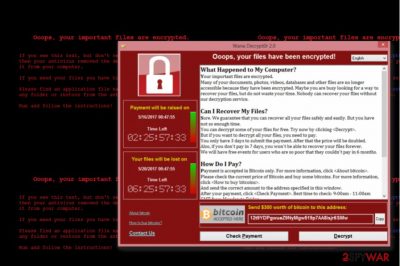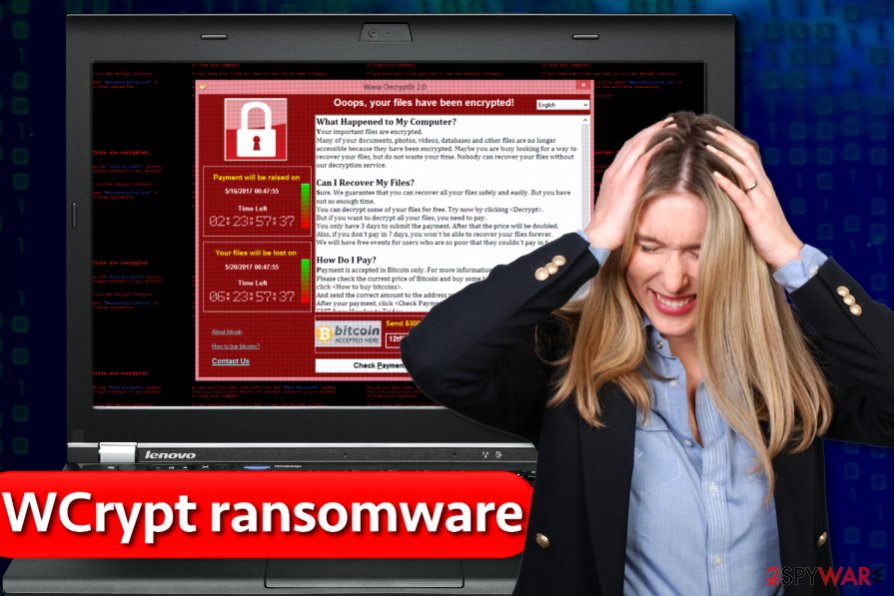WCrypt ransomware / virus (Removal Instructions) - Bonus: Decryption Steps
WCrypt virus Removal Guide
What is WCrypt ransomware virus?
Things to know if Wcrypt ransomware attacked your computer
Wcrypt virus is a ransomware that locks down all files on infected computers or networks and demands a ransom in exchange for a data recovery solution[1]. The first versions of this ransomware emerged in February 2017, and now it has various different names such as WannaCry, Wcry, Wncry, WannaCryptor, WannaCrypt0r, WanaCrypt0r 2.0, Wana Decrypt0r, Wana Decrypt0r 2.0[2] or even DarkoderCrypt0r ransomware. As soon as this dangerous program sneaks into the computer system, it corrupts all data stored on it in seconds. During this procedure, the virus might add .Wcrypt file extensions to affected files. Other versions of this virus are known to be adding .wcry or .wncry file extensions. The aim of such encryption procedure is to render victim’s data useless and demand a ransom. The victim can easily ignore the extortion tool in case he has a data backup; however, in the majority of cases, computer users forget to create these data copies on time. In such case, the only way to restore encrypted files is to pay cyber criminals, however, we strongly recommend you not to do so. Remember that frauds usually show no interest to interact with the victim after receiving the ransom, since money is all that they seek for. Instead, we suggest removing the ransomware using anti-malware tools like FortectIntego or SpyHunter 5Combo Cleaner according to Wcrypt removal guide we provided below.


Distribution of Wcrypt ransomware
Wcrypt, which is also known as WannaCry ransomware, shook the virtual community on 12 May 2017. On that day, a massive cyber attack against Microsoft Windows users was implemented. The attackers used EternalBlue exploit[3] to infect computer systems and take all victim’s files hostage. Besides, the ransomware itself works as a work that looks for connected computers and replicates itself on them. Although at the moment it seems that the ransomware no longer attacks new victims (since a security researcher accidentally stopped the cyber attack), experts advise that it is too early to rejoice[4]. The authors of the malware might be hiding another trick to distribute the virus, so computer users should take every possible measure to protect the computer from such cyber attack. Although we usually recommend installing anti-malware software and regularly updating all computer programs, we must point out that data backup is likely to be the only savior capable of restoring your files. If you do not have it yet, create it as soon as you can. Simply create a copy of valuable data, transfer it onto a portable data storage device, and unplug the device from the computer. You believe that you will also be interested in these tips on how to survive Wcrypt attack.
Wcrypt removal explained
Due to reasons we mentioned in previous paragraphs, it is a must to remove Wcrypt virus as soon as possible. Keeping the computer on the system is not safe because it can quickly replicate[5] itself on other computers or portable devices in case someone plugs them into the compromised PC. The most secure way to complete Wcrypt removal is to perform a full system check using anti-malware software. To start it, you must prepare your computer first. Follow these instructions to eliminate the virus completely.
Getting rid of WCrypt virus. Follow these steps
Manual removal using Safe Mode
Important! →
Manual removal guide might be too complicated for regular computer users. It requires advanced IT knowledge to be performed correctly (if vital system files are removed or damaged, it might result in full Windows compromise), and it also might take hours to complete. Therefore, we highly advise using the automatic method provided above instead.
Step 1. Access Safe Mode with Networking
Manual malware removal should be best performed in the Safe Mode environment.
Windows 7 / Vista / XP
- Click Start > Shutdown > Restart > OK.
- When your computer becomes active, start pressing F8 button (if that does not work, try F2, F12, Del, etc. – it all depends on your motherboard model) multiple times until you see the Advanced Boot Options window.
- Select Safe Mode with Networking from the list.

Windows 10 / Windows 8
- Right-click on Start button and select Settings.

- Scroll down to pick Update & Security.

- On the left side of the window, pick Recovery.
- Now scroll down to find Advanced Startup section.
- Click Restart now.

- Select Troubleshoot.

- Go to Advanced options.

- Select Startup Settings.

- Press Restart.
- Now press 5 or click 5) Enable Safe Mode with Networking.

Step 2. Shut down suspicious processes
Windows Task Manager is a useful tool that shows all the processes running in the background. If malware is running a process, you need to shut it down:
- Press Ctrl + Shift + Esc on your keyboard to open Windows Task Manager.
- Click on More details.

- Scroll down to Background processes section, and look for anything suspicious.
- Right-click and select Open file location.

- Go back to the process, right-click and pick End Task.

- Delete the contents of the malicious folder.
Step 3. Check program Startup
- Press Ctrl + Shift + Esc on your keyboard to open Windows Task Manager.
- Go to Startup tab.
- Right-click on the suspicious program and pick Disable.

Step 4. Delete virus files
Malware-related files can be found in various places within your computer. Here are instructions that could help you find them:
- Type in Disk Cleanup in Windows search and press Enter.

- Select the drive you want to clean (C: is your main drive by default and is likely to be the one that has malicious files in).
- Scroll through the Files to delete list and select the following:
Temporary Internet Files
Downloads
Recycle Bin
Temporary files - Pick Clean up system files.

- You can also look for other malicious files hidden in the following folders (type these entries in Windows Search and press Enter):
%AppData%
%LocalAppData%
%ProgramData%
%WinDir%
After you are finished, reboot the PC in normal mode.
Remove WCrypt using System Restore
-
Step 1: Reboot your computer to Safe Mode with Command Prompt
Windows 7 / Vista / XP- Click Start → Shutdown → Restart → OK.
- When your computer becomes active, start pressing F8 multiple times until you see the Advanced Boot Options window.
-
Select Command Prompt from the list

Windows 10 / Windows 8- Press the Power button at the Windows login screen. Now press and hold Shift, which is on your keyboard, and click Restart..
- Now select Troubleshoot → Advanced options → Startup Settings and finally press Restart.
-
Once your computer becomes active, select Enable Safe Mode with Command Prompt in Startup Settings window.

-
Step 2: Restore your system files and settings
-
Once the Command Prompt window shows up, enter cd restore and click Enter.

-
Now type rstrui.exe and press Enter again..

-
When a new window shows up, click Next and select your restore point that is prior the infiltration of WCrypt. After doing that, click Next.


-
Now click Yes to start system restore.

-
Once the Command Prompt window shows up, enter cd restore and click Enter.
Bonus: Recover your data
Guide which is presented above is supposed to help you remove WCrypt from your computer. To recover your encrypted files, we recommend using a detailed guide prepared by 2-spyware.com security experts.If you do not have data backup but you want to restore your files, follow these steps. Remember that these methods aren't meant to restore files particularly encrypted by WannaCry, however, it won't hurt to try every possible data recovery solution.
If your files are encrypted by WCrypt, you can use several methods to restore them:
Use DataRecoveryPro
DataRecoveryPro is known as a tool that easily finds and restores deleted or corrupted files, so using it in case of a ransomware attack is a must. Here are the instructions on how to use this tool.
- Download Data Recovery Pro;
- Follow the steps of Data Recovery Setup and install the program on your computer;
- Launch it and scan your computer for files encrypted by WCrypt ransomware;
- Restore them.
ShadowExplorer help
If the ransomware was killed before it managed to reach Volume Shadow Copies to delete them, we strongly recommend running ShadowExplorer. This tool helps to find VSS and it to restore corrupted files.
- Download Shadow Explorer (http://shadowexplorer.com/);
- Follow a Shadow Explorer Setup Wizard and install this application on your computer;
- Launch the program and go through the drop down menu on the top left corner to select the disk of your encrypted data. Check what folders are there;
- Right-click on the folder you want to restore and select “Export”. You can also select where you want it to be stored.
No Wcrypt decryptor
Finally, you should always think about the protection of crypto-ransomwares. In order to protect your computer from WCrypt and other ransomwares, use a reputable anti-spyware, such as FortectIntego, SpyHunter 5Combo Cleaner or Malwarebytes
How to prevent from getting ransomware
Do not let government spy on you
The government has many issues in regards to tracking users' data and spying on citizens, so you should take this into consideration and learn more about shady information gathering practices. Avoid any unwanted government tracking or spying by going totally anonymous on the internet.
You can choose a different location when you go online and access any material you want without particular content restrictions. You can easily enjoy internet connection without any risks of being hacked by using Private Internet Access VPN.
Control the information that can be accessed by government any other unwanted party and surf online without being spied on. Even if you are not involved in illegal activities or trust your selection of services, platforms, be suspicious for your own security and take precautionary measures by using the VPN service.
Backup files for the later use, in case of the malware attack
Computer users can suffer from data losses due to cyber infections or their own faulty doings. Ransomware can encrypt and hold files hostage, while unforeseen power cuts might cause a loss of important documents. If you have proper up-to-date backups, you can easily recover after such an incident and get back to work. It is also equally important to update backups on a regular basis so that the newest information remains intact – you can set this process to be performed automatically.
When you have the previous version of every important document or project you can avoid frustration and breakdowns. It comes in handy when malware strikes out of nowhere. Use Data Recovery Pro for the data restoration process.
- ^ Ransomware attacks were on the rise, even before the latest episode. The Economist. World News, Politics, Economics, Business & Finance.
- ^ Victoria Woollaston. Wanna Decryptor ransomware appears to be spawning and this time it may not have a kill switch. WIRED UK. Future Science, Culture & Technology News and Reviews.
- ^ Catalin Cosoi. EternalBlue-powered ransomware will become the new normal. HOTForSecurity. The Blog on the Sizzling World of Computer Security.
- ^ Julio Hernandez-Castro. I'm an expert in cyber security. This is what I can tell you about the global malware attack – and how it will evolve. The Independent - News. UK and Worldwide News.
- ^ WannaCrypt ransomware worm targets out-of-date systems. Microsoft Technet. The New Microsoft Malware Protection Center Blog.





















